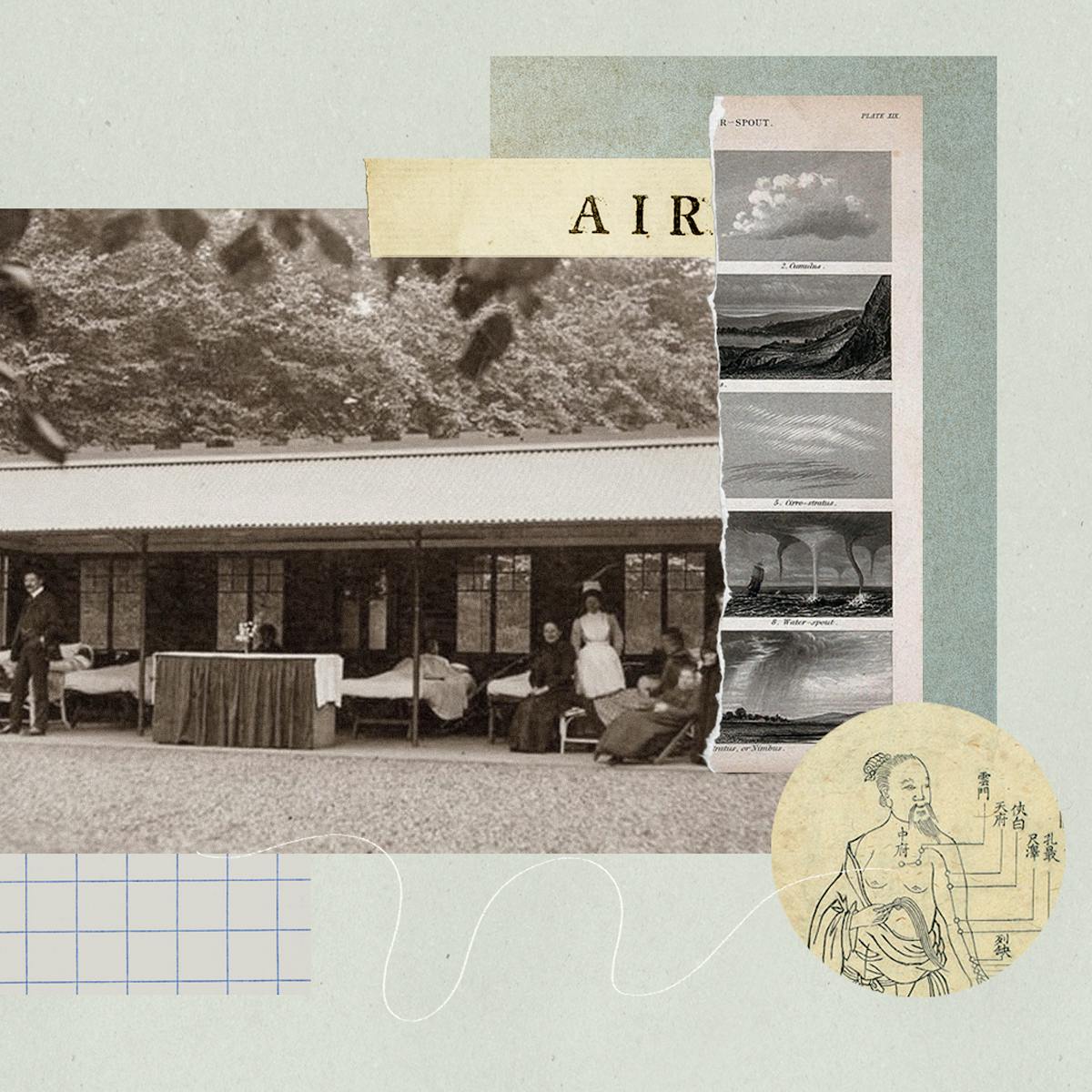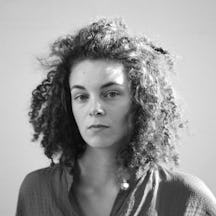Air is life-giving; it can also be toxic. A change of air can transform how we feel – whether that’s a drop in air pressure that makes our joints ache and our thoughts slow, or fresh air as an answer to ill health. Daisy Lafarge explores air as cure, but one with contradictions, reflecting on our ambivalent relationship with the atmosphere.
On the other side of the railway tracks, close to my old flat in Glasgow, looms the Victorian gothic edifice of Gartnavel Royal Hospital. New buildings and car parks lap the base of the hill on which the older buildings sit, many now derelict, with buddleia and knotweed growing through cracks in their red stone and boarded-up windows.
Walking around the grounds of Gartnavel makes for a strange experience; its coexistence of new and old, use and disuse, can feel like the pages of history are leaching into each other. Nestled among the fenced-off buildings is a walled garden and medicinal herb bed still tended by patients, while a path to the west of the complex offers one of the most dramatic viewpoints in the city, from which you can see the edges of Glasgow fade out, and the silhouetted Kilpatrick Hills indent the skyline.
The site has gone through several lives over the last 200-odd years, starting out as the Glasgow Lunatic Asylum in 1804, gaining its ‘Royal’ epithet in 1824, and the new name of Glasgow Royal Mental Hospital in 1931. Today, the new complex continues to provide inpatient psychiatric care.
In the late 19th century, the hospital was famous for its “tent therapies” in which fresh air and sunlight were considered integral to the healing process; restless patients were calmed by staying in beds outside, and receiving treatment in open-air pavilions erected in the hospital’s extensive grounds. These pavilions and airing courts embody the “change of air” principle that was crucial to Victorian medical practice.
We tend to use “a change of air” figuratively, but for Victorian medical practice it was an indispensable prescription. A change of air was advised for a variety of ailments, ranging from tuberculosis to melancholy.
Before 1850, tuberculosis was responsible for a quarter of deaths worldwide, and the lack of a known cure meant that care became mostly palliative: doctors focused their energies on encouraging patients to procure the best environments for their healing. For those who could afford it, health travel became fashionable as “good air” was sought throughout the UK – in seaside resorts such as Torquay, Rothesay and Hastings – and increasingly further afield, as a preference developed for alpine climates and inland resorts abroad.
The Victorian change of air echoes classical medicine’s belief in the entwining of air and health. For the Greek physician Hippocrates, it was impossible to claim to know the body unless you also knew the environment and climate a body lived in, since “with the seasons men’s diseases, like their digestive organs, suffer change”.
The Hippocratic text ‘Airs, Waters, Places’ begins with a list of various winds and how they affect the people subject to them: those living in cities exposed to hot summer winds are ‘moist’, with heads and digestive organs full of phlegm, a condition that augurs certain illnesses (asthma, ague, chronic fever) and prevents others (pleurisy, pneumonia); while those living in cities facing the cold winds over winter are more bilious in composition, prone to internal lacerations, inflammations of the eye and nosebleeds.
Perhaps it’s unusual now to think of the body being so vulnerable to air. Only children are expected to be gullible enough to believe that, while pulling faces, “if the wind changes you’ll stay like that”. Certain winds might make us feel “chilled to the bone”, but few would attribute the origin of their ailments to the winds themselves.
The Hippocratic tradition distinguished different types of air under the umbrella term pneuma: inside the body as breath (physa), outside the body as air (aer), and air that flowed as wind (anemos). In classical Chinese medicine, the historian Shigehisa Kuriyama explains that the movement of air around and through the body was more fluid and less compartmentalised, but still regarded as the chief cause of illness.
While Greek medicine acknowledged that bodies were affected (and afflicted) by their airy environments, Chinese traditions emphasised a physical continuity between the two. The term xue (holes or caverns) was used to describe both the ‘hollows’ of the earth where winds would flow, and to denote parts of the body where winds would rush in and out. Xue also map onto the points used in acupuncture to direct the flow of qi around the body – a term that was often used interchangeably with feng or wind.
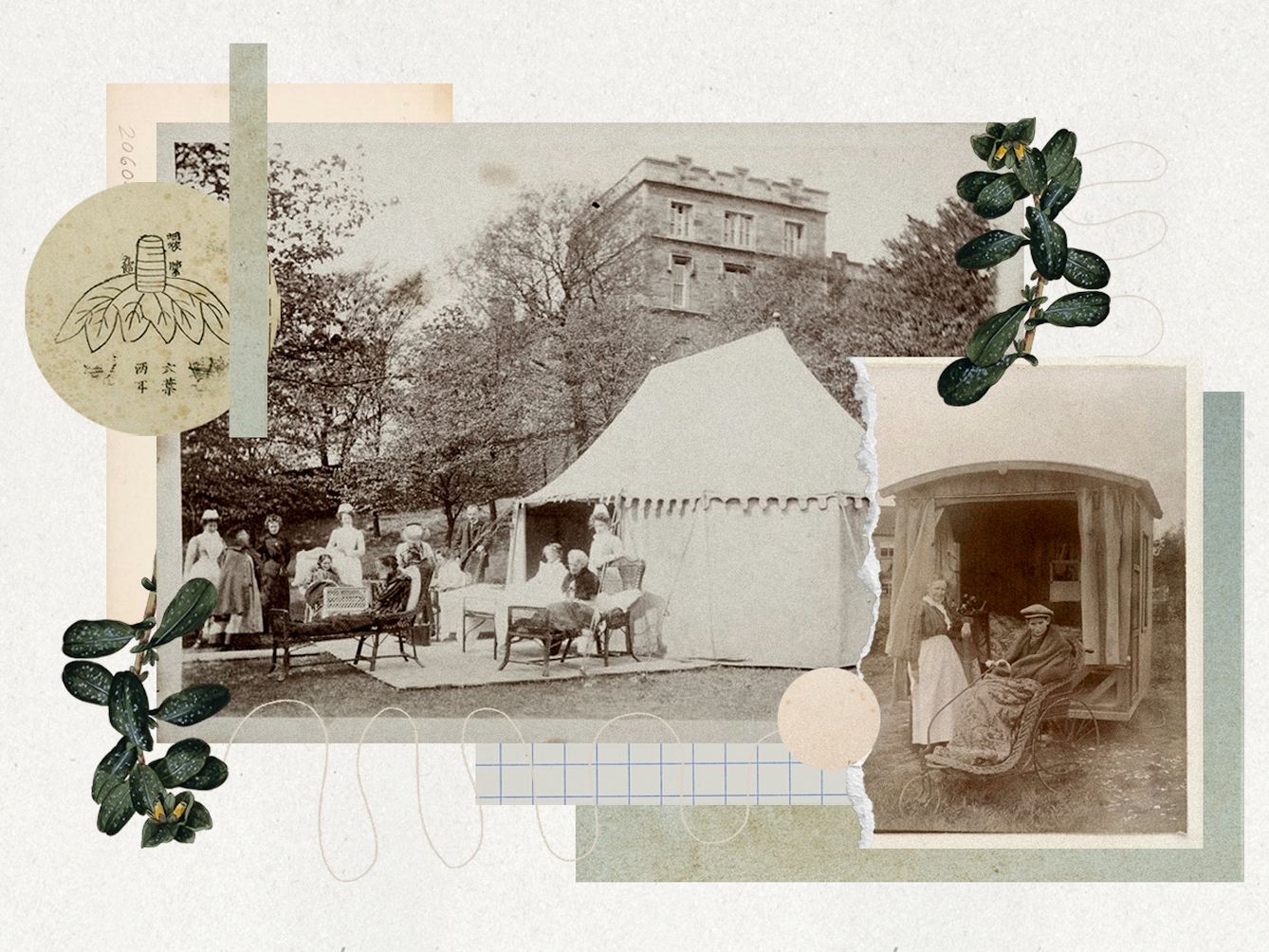
“In the late 19th century, Gartnavel Royal Hospital was famous for its ‘tent therapies’ in which fresh air and sunlight were considered integral to the healing process.”
If these two classical traditions gave prominence to air and wind as the aetiology of illness, they also acknowledged the inverse carried within it, that exposure to different airs – or a skilled redirection of air (conceptualised as qi)– would bring about its cure. This duality exemplifies the notion of the pharmakon: a poison that is also its own remedy.
Jacques Derrida describes the pharmakon as an ‘ambivalent’ figurative space in which opposites commingle without being reduced to one thing or the other. Both in the classical conception of air as mediator of sickness and health, and in the contemporary context of air as both life-giving and potentially toxic, what could be more pharmakon-like than air?
Births and breaths
This vital ambivalence is at the heart of our interdependency with air. Drawing on the work of Jacques Lacan, the psychoanalyst Jamieson Webster describes a just-born baby’s experience of air as a trauma that is universal in nature. The womb is a place before air, in which breathing is done on our behalf by the person carrying us.
The trauma of birth, then, is a trauma of breath: suddenly exposed to the airy expanse of the atmosphere, we are expected, for the first time, and with no prior warning, to breathe for ourselves. In this view, taking a first breath – the inhalation of a foreign substance, no longer mediated by the parent’s body – is both an invasion and an abandonment, a shared trauma underpinning the entry into life.
The trauma of birth, then, is a trauma of breath: suddenly exposed to the airy expanse of the atmosphere, we are expected… to breathe for ourselves.
Perhaps this jettisoning from the space of the womb to the world outside is why tricky conceptualisations of air as a ‘maternal’ space run rife. If I find myself wincing at this association, I also recognise in it a counterpoint to ancient associations of sky and air with masculinity. In many ancient cultures the sky was personified as masculine because its rain was the ‘seed’ that fertilised ‘mother’ earth.
Unique among these was Egyptian mythology, in which the sky was coded feminine in the figure of the goddess Nut. Nut was most often depicted as a naked woman, her skin spangled with stars, contorting over the earth like an acrobat. In the two-dimensional plane of her representation, the contact of Nut’s hands and feet with the earth form a sealed atmosphere, a hermetic space in which all life on earth could thrive.
Here the goddess is an omnivorous mother, swallowing and birthing the sun anew each day. She was also sometimes depicted as a great cow or sow, suckling calves or piglets that represented the stars.
In a series of works by the artist Nancy Spero, Nut’s contact with solid ground is severed. Her arched figure is repeated and rotated, centrifugally spun through figurative space. If the function of Nut’s arched position was to form a barrier between the chaos above her and the orderly world below, in Spero’s depictions the barrier has been broken: chaos is unleashed, and Nut somersaults through air as a wild atmosphere.
I hold Spero’s goddess as a talisman against conceptions of the air as an idyllic ‘maternal’ medium; Nut may be a mother of sorts, but she is one held aloft by her ambivalence, as chaos leaches into calm around her.
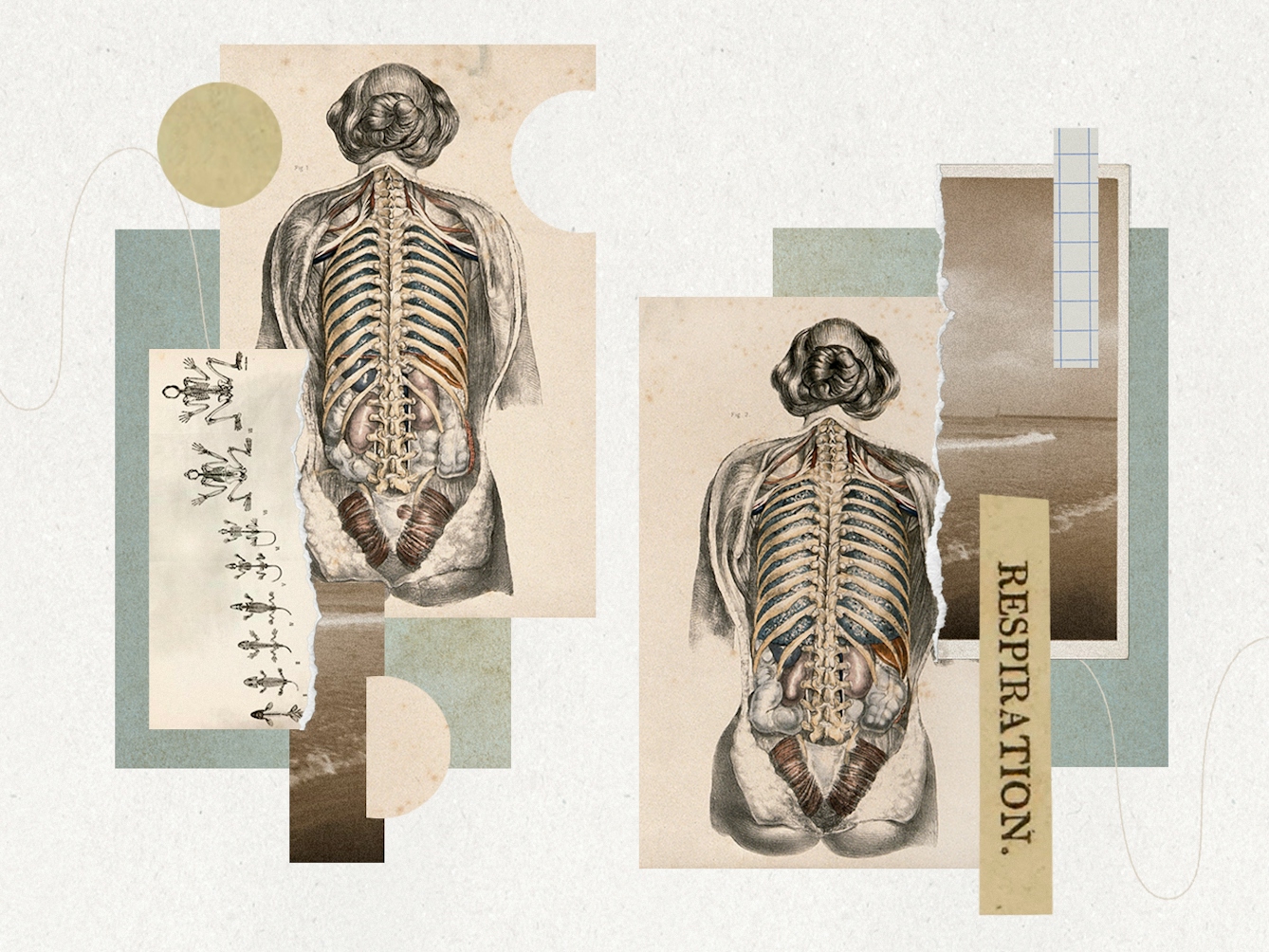
“Lungs were one of the last acquisitions in human evolutionary development, dating to roughly 360 million years ago. They derive from early fish, who developed simple sacs on their oesophagus to allow them to gulp air when oxygen was in short supply.”
Under pressure
I feel the ambivalence of air most keenly during drops in air pressure. Like many people, I am sensitive to these fluctuations, a vulnerability I attribute – depending on how whimsical I am feeling – either to my genetic joint condition, or to the old wives’ tale that being born by the sea (as I was) increases your sensitivity to drops in pressure below sea level. At sea level, the atmospheric pressure is 1013.25 millibars (or hectopascals – referring to the weight of the air around us), which is thought to provide the optimal conditions for the human body.
When the pressure drops – as it does before storms, strong winds and rain – I begin to experience symptoms: my joints ache and swell, my thoughts become slow and fuzzy, accompanied by headaches and low moods. It’s a dissociative experience; I feel as if the line between me and my environment has become smudged, blurring me from my body.
It’s taken years for me to connect this diffuse set of symptoms with a sensitivity to air pressure, and I still find it easy to forget, raking through the day for more visible, identifiable triggers. But sometimes, in the midst of the blurring effect, I remember to check the barometer app on my phone, and sure enough, find that my symptoms are coinciding with a reading below 1013.25.
It’s difficult to keep in mind what we cannot see; air pressure illustrates the flaw in “out of sight, out of mind”, because air pressure is very much in our minds, and in our bodies as a whole.
At optimum atmospheric pressure, the weight of the air pushes against us, applying pressure that constricts the body’s soft tissue. This sounds uncomfortable, but it is exactly the opposite; it is periods of low pressure that can become painful for the body, when we are no longer tightly held by the air, and our tissue and joints expand and swell. We go about our lives with an indifference to air, unaware of the firm embrace it binds us in, literally holding us together.
As Jamieson Webster notes, lungs were one of the last acquisitions in human evolutionary development, dating to roughly 360 million years ago. Human lungs, like the lungs of all terrestrial vertebrates, derive from early fish, who developed simple sacs on their oesophagus to allow them to gulp air when oxygen was in short supply.
Many invertebrates, such as insects and spiders, lack ‘lungs’ in any recognisable sense, and instead breathe through openings in their exoskeletons called spiracles. Other species of spider, as well as scorpions, possess “book lungs”, which are unrelated to mammalian lungs, and are composed instead of alternate layers of air pockets and tissue that resemble the pages of a closed book. The term respiration allows us to gather together these differences under a common cyclicality; re- inscribing a recursion of spirare, to breathe or blow.
The etymologist Michiel de Vaan has suggested that spirare was an onomatopoeic formation that imitated the sound of breathing. Regardless of this origin story’s veracity, I think it is a useful one, reminding us of the interdependency of breath and voice. The ecological philosopher David Abram notes that many ancient alphabets lacked vowels because vowels are simply unimpeded breath, whereas consonants are shaped breath. Vowels therefore had no need for inscription because they were implicit between consonants, the bones of language.
Breath reaches into the space where language can’t. The ‘Bhagavad Gita’ – a sacred Hindu text compiled in the first millennium BCE – includes a description of pranayama, the yogic practice of focused breath. The Sanskrit word is composed of prana, meaning ‘vital life force’, and yama, meaning ‘control’. Through a variety of practices, pranayama is an active suspension of the breath with the intention of clearing blockages in the body and allowing its energies to flow.
In recent years pranayama has attained something of a mainstream popularity, thanks to its proven effects on calming the nervous system, decreasing stress, reducing high blood pressure and improving lung function, including a reduction of “dead space” in the lungs.
Breathing becomes a form of speech through which we commune with air, dispersing the need for familiar and available metaphors.
Jamieson Webster describes working with pranayama alongside her analytic practice; the Christian mystic Simone Weil – also a student of the ‘Bhagavad Gita’ – wondered if respiratory yoga “is not so much a technique as a way to make breathing itself a sacrament”, underlining the importance of not severing the physiological ‘benefits’ of a practice like pranayama from its sacred context, in which breath is the vitality of life itself.
If breathing and speaking are closer than we might presume, then perhaps it’s breathing, rather than language, that might draw us closer to articulating our relationship to air. Breathing becomes a form of speech through which we commune with air, dispersing the need for familiar and available metaphors, like the maternal. Rather, breathing is sempiternal – the spirare of multispecies life blowing into the “dead space” in language.
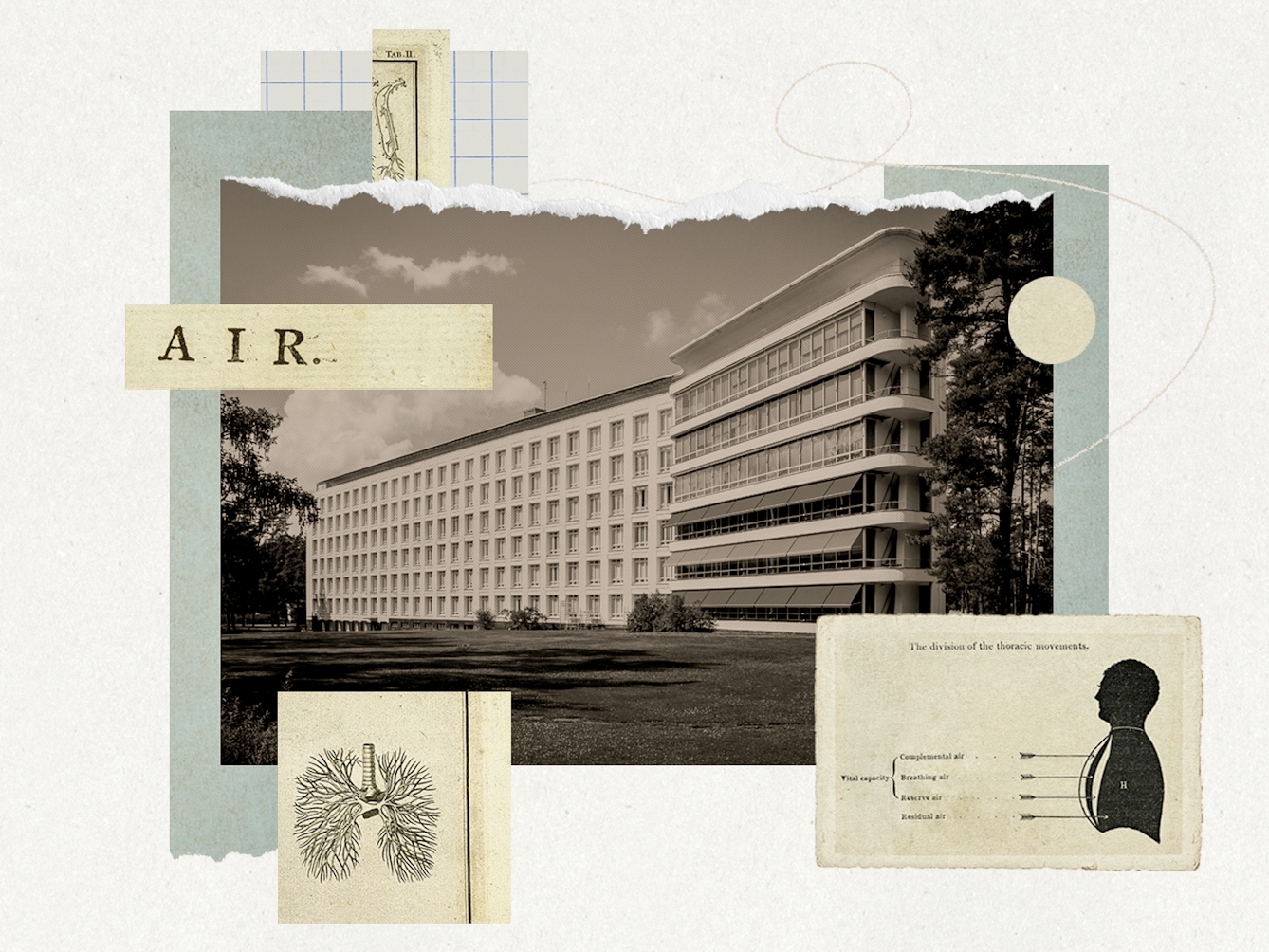
“Like the air pavilions of Gartnavel, the sanatorium at Paimio was designed with the air in mind, where patients were encouraged to lie out and take the air on balconies overlooking the dense forest canopy.”
Our invisible ally
In 2012, I was living in a small city in southwest Finland on an Erasmus exchange programme. During these months I embarked on a series of pilgrimages to buildings around the country designed by the Finnish architect and designer Alvar Aalto. This is how I ended up at a tuberculosis sanatorium in Paimio, which Aalto had won a competition to design in 1928, when he was 30 years old.
The sanatorium’s construction came at the tail end of the so-called air cure, when tubercular patients were prescribed rest and “air-baths” in vivifying retreats. Like the air pavilions of Gartnavel, the sanatorium at Paimio was designed with the air in mind, where patients were encouraged to lie out and take the air on balconies overlooking the dense forest canopy.
When I visited, the entire complex was empty but sparkling clean. Aside from me, the only visitors were a middle-aged Japanese couple who, like me, had navigated a succession of rural buses to reach the site. As we were shown around, the guide narrated a series of design features, which Aalto had specified down to the smallest details.
Aalto had no medical background but took the purpose of the building seriously; he decided that the sanatorium itself must be a “medical instrument” to ameliorate its patients’ healing. The guide drew our attention to the curved lines that joined the walls to the floor and explained how the building had been designed without right angles, to prevent the accumulation of dust that might irritate patients’ lungs.
I hadn’t read Thomas Mann’s novel ‘The Magic Mountain’ before my visit, but when I did so years later, it was Paimio I was transported back to. Published just a few years before Paimio was built, the novel follows 23-year-old Hans Castorp, who starts out by visiting his sick cousin in a sanatorium in the Swiss Alps and ends up becoming a long-term patient himself. The curative qualities of air in ‘The Magic Mountain’ are elusive; air becomes an embodiment of time, which works like Lethe, one of the rivers of Hades whose waters bring about forgetfulness and oblivion.
The change of air provided by life in the sanatorium is psychological as much as it is physical, calling such a distinction into question. Hans Castorp drinks the fresh air – or time – of Lethe, and forgets his former, conventional life in the world below; over the course of the novel he undergoes an existential transformation that opens him up to a seemingly infinite contemplation of life itself.
The psychic recomposition of Hans Castorp reminds us that the etymology of psyche is akin to the Greek psykhein, to blow or breathe. The life of the mind is not static, but animated by the air-like currents that blow and breathe through it.
Attuning to air could help us coexist with the anxieties and psychic ailments of climate crisis.
If a change of air is not in itself curative, but constitutive of psychic survival, it might be that attuning to air could help us coexist with the anxieties and psychic ailments of climate crisis.
Solastalgia has been dubbed the mental health disorder of the Anthropocene, denoting the grief and distress provoked by environmental devastation. The loop of solastalgia is as infinite as the news reports and statistics that feed it, and the solastalgic patient, unlike their tubercular counterpart, can find no solace in the Lethe of retreat.
But a change of air reminds us that change is not a one-way street to inevitable doom: the first wave of global lockdowns showed how rapidly and drastically air pollution levels can be reduced, almost overnight. Air might not cure or mother us, but it remains, in spite of its ambivalence, an ally in hope.
About the contributors
Daisy Lafarge
Daisy Lafarge was born in Hastings and studied at the universities of Edinburgh and Glasgow. Her collection of poetry ‘Life Without Air’ (Granta Books) was shortlisted for the T S Eliot Prize 2020 and was recommended by the Poetry Book Society. Her debut novel ‘Paul’ received a Betty Trask Award, and was published by Granta Books in August 2021.
Carol Nazatto
Carol is a Brazilian collage artist. She holds a degree in fashion design and another in art history, something that has directly influenced her work as an artist. In collage she found her path to create narratives and visual poetry. Carol likes to mix images from the past with miscellaneous elements, creating new universes, her aim is to always bring a contemporary perspective to the past and to the memories around her. Carol is represented by Artistique.
